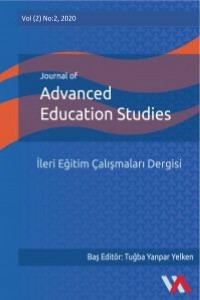INVESTIGATION OF 5TH GRADE STUDENTS’ OPINIONS ON THE IMPLEMENTATIONS OF ACTIVE LEARNING AND COMPUTER ASSISTED LANGUAGE LEARNING
This study aimed to determine 5th grade students’ opinions on the implementation of active learning and computer assisted language learning (CALL). In the study, survey method, which is one of the qualitative research methods, was employed. The participants of the study consisted of nine 5th grade students. The data were collected through open-ended questions prepared by the researchers, and content analysis was performed in the analysis of the data. As a result of the study, it was determined that the students both have positive and negative opinions on English classes in general. Among the positive opinions students stated that the classes were very enjoyable, effective and included teacher support. On the contrary students expressed their negative opinions by saying that the classes were difficult, boring and there were a lot of homework. On the other hand, students stated that the implementation was enjoyable, effective and helpful. Besides, students said that they wanted to have more activities and more games. The findings showed that students liked the implementation and they mostly had positive opinions on the issue. Therefore, in the classroom environment the implementations which give more responsibilities to the students should be increased. Moreover, when considering the ages of the students, more enjoyable and game-based activities should be conducted in learning process to improve learning.
Anahtar Kelimeler:
English language teaching, active learning, computer assisted learning
INVESTIGATION OF 5TH GRADE STUDENTS’ OPINIONS ON THE IMPLEMENTATIONS OF ACTIVE LEARNING AND COMPUTER ASSISTED LANGUAGE LEARNING
This study aimed to determine 5th grade students’ opinions on the implementation of active learning and computer assisted language learning (CALL). In the study, survey method, which is one of the qualitative research methods, was employed. The participants of the study consisted of nine 5th grade students. The data were collected through open-ended questions prepared by the researchers, and content analysis was performed in the analysis of the data. As a result of the study, it was determined that the students both have positive and negative opinions on English classes in general. Among the positive opinions students stated that the classes were very enjoyable, effective and included teacher support. On the contrary students expressed their negative opinions by saying that the classes were difficult, boring and there were a lot of homework. On the other hand, students stated that the implementation was enjoyable, effective and helpful. Besides, students said that they wanted to have more activities and more games. The findings showed that students liked the implementation and they mostly had positive opinions on the issue. Therefore, in the classroom environment the implementations which give more responsibilities to the students should be increased. Moreover, when considering the ages of the students, more enjoyable and game-based activities should be conducted in learning process to improve learning.
Keywords:
Active learning computer assisted learning, computer assisted language teaching, English language teaching,
___
- Alves M. (2015). Ways to apply active learning in the college ESL classroom. College ESL Quarterly Spring 2015.
- Attaran A., Gholamı V. & Moghadda M. M. (2014). The effects of active learning on foreign language self-concept and reading comprehension achievement. International Journal on New Trends in Education & Their Implications (IJONTE) 3(4).
- Bonwell, C. C., & Eison, J. A. (1991). Active learning: Creating excitement in the classroom. ASHE-ERIC Higher Education Report No. 1. Washington, DC.
- Derakhshan, A., Salehi, D., & Rahimzadeh, M. (2015). Computer-assisted language learning (Call): Pedagogical pros and cons. International Journal of English Language and Literature Studies, 4(3), 111-120.
- Er, M., Altunay,U., &Yurdabakan, İ. (2012). The effect of active learning on foreign language self concept and reading comprehension achievement. International Journal on New Trends in Education and Their Implication, 3(4), 43-58.
- Eslit, E. (2014). Computer Assisted Language Teaching: Learning Without Dust. Retrieved from:https://www.academia.edu/11536522/COMPUTER_ASSISTED_LANGUAGE_T EACHING_LEARNING_WITHOUT_DUST
- Gunduz, N. (2005). Computer assisted language learning. Journal of Language and Linguistics Studies, 1(2), 193–214.
- Yin, R. K. (2003). Case study research: Design and methods (3rd ed.). Thousand Oaks, CA: Sage.
- ISSN: 2687-3087
- Yayın Aralığı: Yılda 2 Sayı
- Başlangıç: 2019
- Yayıncı: Tuğba YANPAR YELKEN
Sayıdaki Diğer Makaleler
Tugba BADEMCİ, Özgen ŞAHİN BEKTAŞ
ÖĞRETMENLERİN BİR EĞİTİM ARACI OLARAK SOSYAL MEDYAYI KULLANMALARINA İLİŞKİN GÖRÜŞLERİ
ÜNİVERSİTE ÖĞRENCİLERİNİN ÜNİVERSİTE EĞİTİMİ VE YAŞAMINA İLİŞKİN PROBLEMLERİ: BİR DURUM ÇALIŞMASI
Fadime ARİCİ, Özgür EKİN, Akın EFENDİOĞLU
EPİSTEMOLOJİK İNANÇ ÖLÇEĞİ'NİN GEÇERLİK ve GÜVENİRLİK ÇALIŞMASI
